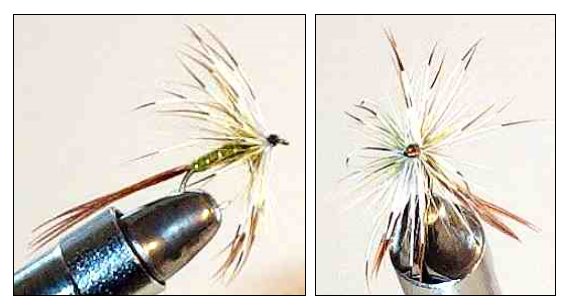Olive French Partridge Mayfly Spinner
The spider like Partridge hackle series of trout flies have been around for over two hundred years. There are many variations and they all catch fish. They can be used to suggest a drowned mayfly spinner or stonefly. Yellow, Green and Brown Drakes are not the largest mayflies of the summer hatches but they are certainly much bigger than the early Blue Winged olive and Blue Dun hatches of early spring.

MAYFLY SPINNER DRY FLY PATTERNS. Hook size 12 16 - $US each
They belong to the Ephemeridae family mayflies. They have all a deserved reputation for producing great hatches that can entice large lurker trout to leave their lays and feed greedily on the hatching Drakes. When they do hatch their emergence is not a subtle event. After breaking through the surface film and their nymphal shucks these large duns struggle frantically to get off the water. This makes them very conspicuous and easy prey for both birds and trout. They float for long distances waiting for their wings to fill with blood. When the wings are fully inflated and dry these duns flutter furiously as they try to lift their large bodies into the air. This fluttering action often is the trigger for some violent strikes. As nymphs all three species prefer slow moving water that has a river bed of fine sand, gravels or silt. During a hatch you will find the greatest concentration in these same areas. The slow moving water gives the trout a very clear view of it's target.
About the same time the Brown Drakes are on the water the Green Drake hatches start. In some places these hatches only last five to eight days, but in other areas they last much longer. Large concentrations are rarely seen on the water. They emerge sporadically but the trout and bass know it is Green Drake hatch time. Drift a Olive French Partridge fly over a quiet pool in the early evening and see what happens. Be ready to set the hook. Some mayflies do not make it into the air. They drown. Use a wet mayfly like our wet green mayfly pattern or one of our spider patterns. Fish upstream and let it just drift to imitate the dead insect. It is an easy meal for a trout. Spider patterns are always a good standby to attract the larger trout. These terrestrials can be swept away current as the build their webs on over hanging riverbank plants. In the evenings of mid spring to early summer the water surface can be littered with the fallen mature mayfly spinners. This is the time the big trout rise to the surface and feasts
Did you know you can fish your dry flies as nymphs. This is a very successful technique during and after a hatch. The majority of aquatic insects that Rainbow and Brown trout feed on are taken under the water surface. It is believed that only 20% of a trout’s food is taken from the top. During the hatch many emerging mayflies and caddis do not make it into full adulthood. They are cripples, duns that cannot get themselves free of their nymphal skin. Duns that drown in rough water or are blown over on to their side whilst floating in the surface film waiting for their wings to dry out and harden also become fish food. These unlucky mayflies and caddis make easy pickings for trout waiting below rapids or heavy riffles.
To imitate them just fish a dry fly that imitates the hatching insect and fish it as a nymph below the surface. Use split shot on your leader to get them to the required depth. I aim to fish them to a depth of 1 – 3 feet. Remember these insects are dead: they have drowned. Fish them in a dead drift with no drag on your line, leader or tippet. The trout expect to see these unfortunate insects drift past them not trying to fight against the current. That would spook them.


Fly Fishing books

